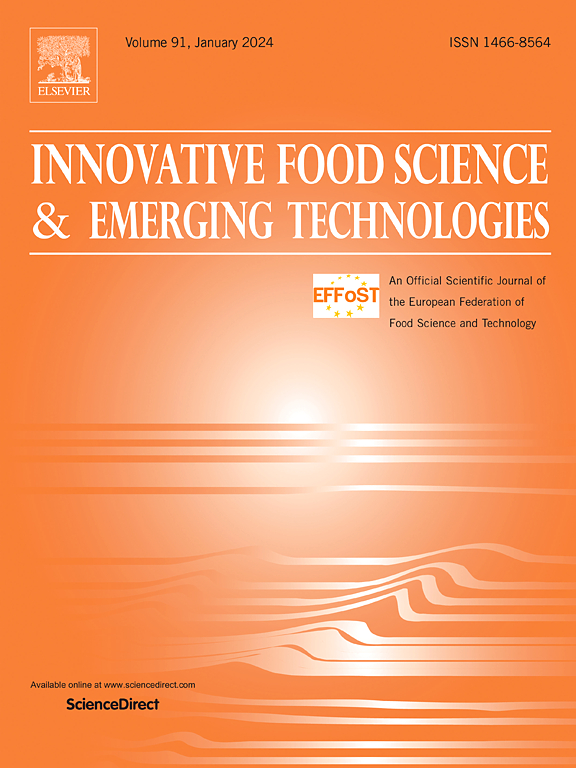Application of pulsed electric field to promote peelability on peponids and drupes: Understanding the effects on cells and the physical properties of fruits
IF 6.3
1区 农林科学
Q1 FOOD SCIENCE & TECHNOLOGY
Innovative Food Science & Emerging Technologies
Pub Date : 2025-07-07
DOI:10.1016/j.ifset.2025.104111
引用次数: 0
Abstract
Pulsed Electric Field (PEF) technology is a non-thermal food processing method gaining attention for its applications in treating fruits and vegetables, particularly for improving peeling efficiency. This study evaluated the effect of PEF on the peeling performance, colour, texture and structural changes in mango and red bell peppers. Blanching at 94 °C (1 and 3 min for mangoes and 1 and 2 min for red bell peppers) was used to compare the effectiveness of traditional peeling methods with PEF treatments, which were applied at 1 kV/cm with energy levels of 1.1 and 4.6 kJ/kg for mangoes and 3.4 and 10.3 kJ/kg for red bell peppers. The results showed that mangoes PEF-treated at 4.6 kJ/kg reduced peeling force by 50 % and peeling loss by 40 %, outperforming blanching (3 min), which achieved a similar reduction in peeling force and a 30 % reduction in peeling loss. Microstructural analysis revealed cell wall modifications and changes in collenchyma and parenchyma, contributing to improved peeling in mangoes. However, PEF did not improve red bell pepper peeling, while blanching for 2 min reduced firmness by 50 %, resulting in cell shrinkage and thicker walls. Furthermore, PEF better preserved the colour of both fruits compared to blanching, which caused more significant colour changes. This finding demonstrates that PEF treatment is an effective peeling method for mangoes, preserving their quality. However, its application is less effective for red bell peppers, likely due to variations in tissue structure and morphological characteristics.

应用脉冲电场促进果核和核果的可剥性:了解对果实细胞和物理特性的影响
脉冲电场(PEF)技术是一种非热食品加工方法,因其在水果和蔬菜加工中的应用而受到人们的关注,特别是在提高去皮效率方面。本研究评价了PEF对芒果和红甜椒去皮性能、颜色、质地和结构变化的影响。采用94°C热烫(芒果1和3 min,红甜椒1和2 min),比较传统脱皮方法与PEF处理的效果。PEF处理的能量水平为1 kV/cm,芒果为1.1和4.6 kJ/kg,红甜椒为3.4和10.3 kJ/kg。结果表明,经4.6 kJ/kg pef处理的芒果,脱皮力降低50%,脱皮损失降低40%,优于焯水(3 min)处理,前者脱皮力降低50%,脱皮损失降低30%。显微结构分析显示芒果细胞壁发生改变,厚壁组织和薄壁组织发生改变,有助于芒果脱皮。然而,PEF并没有改善红甜椒的脱皮,而2分钟的焯水使甜椒的硬度降低50%,导致细胞收缩和壁变厚。此外,与焯水相比,PEF能更好地保存两种水果的颜色,而焯水会导致更显著的颜色变化。这一发现表明PEF处理是一种有效的芒果去皮方法,可以保持芒果的品质。然而,它在红甜椒中的应用效果较差,可能是由于组织结构和形态特征的变化。
本文章由计算机程序翻译,如有差异,请以英文原文为准。
求助全文
约1分钟内获得全文
求助全文
来源期刊
CiteScore
12.00
自引率
6.10%
发文量
259
审稿时长
25 days
期刊介绍:
Innovative Food Science and Emerging Technologies (IFSET) aims to provide the highest quality original contributions and few, mainly upon invitation, reviews on and highly innovative developments in food science and emerging food process technologies. The significance of the results either for the science community or for industrial R&D groups must be specified. Papers submitted must be of highest scientific quality and only those advancing current scientific knowledge and understanding or with technical relevance will be considered.

 求助内容:
求助内容: 应助结果提醒方式:
应助结果提醒方式:


